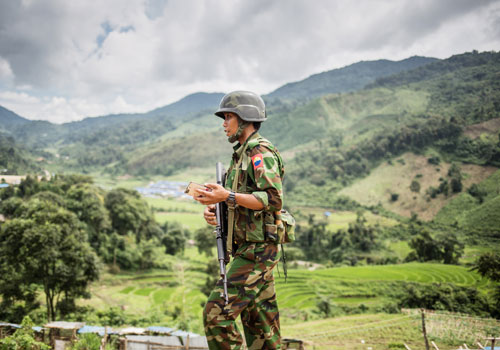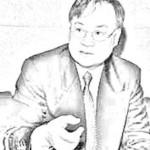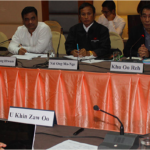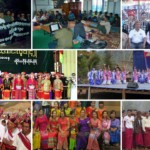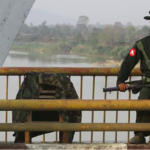By Amrita Dey / Myanmar Times | August 30, 2016
Newly democratic Myanmar is all set to launch its 21st-century Panglong Conference on August 31. State Counsellor Daw Aung San Suu Kyi has stressed that her government is keen to make it as inclusive as possible.
The main objective of this year’s conference mirrors the 1947 Panglong Conference organised by the state counsellor’s father, Bogyoke Aung San, before the country’s independence from Britain.
In his “Blueprint for a Free Burma” written in Japan, Bogyoke Aung San said, “We can confidently assert here that so far as our knowledge of our country goes, there should be no insuperable difficulties in the way of a unified Burma provided all races are given full freedom and the opportunity to meet together and to work without the interference of outside interests.”
The original Panglong Conference saw Bogyoke Aung San, as head of the interim Burmese government, meet with ethnic Kachin, Shan and Chin leaders who unanimously decided to join the republic. The historic meeting also outlined the united struggle for independence and the future of Burma as a unified republic.
Although Bogyoke Aung San was assassinated on July 19, just months after the conference and before independence, the spirit of Panglong shone through.
From Panglong I to Panglong II: timeline
The general terms of the agreement resurfaced in the constitution adopted on September 24, 1947. Though it made no mention of “federal” or “federalism”, it was clear that power was to be divided between Burma proper and the ethnic states.
The country was set to have a bicameral legislature with a 125-seat Chamber of Nationalities and a 250-seat Chamber of Deputies. The Shan and Karenni States were to be reconstituted as one with the extraordinary right of secession after a 10-year trial period – a right adapted from the constitution of the then Soviet Union.
The Kachin, however, apparently abandoned this right in return for the inclusion of the major towns of Myitkyina and Bhamo in the new Kachin State. The Chins who were ethnically divided and always ready to acknowledge their dependence on ministerial Burma ended up without a state; they were formed into a Special Division with few of the political privileges of the Shan and the Kachin.
The final designation and status of a Karen territory and their political rights were left to be decided after independence, while the Mon and Rakhine who were about to go into rebellion, received no distinctive recognition in the constitution.
But the 1947 constitution was termed a “recipe for disaster”, and any goodwill for the Panglong Agreement dissipated when General Ne Win seized power in 1962 and tore up the 1947 constitution.
Among the dozens of political leaders arrested by Gen Ne Win was President Sao Shwe Thaik, an ethnic Shan who had fought to gain minority agreement at Panglong. His youngest son was shot and killed while Sao Shwe Thaik himself died in military custody. Soon after Burma’s independence in 1948, ethnic rebellion began, turning into long, bitter secessionist movements. The 1947 constitution was rewritten in 1974 and once again in 2008.
Seventy years after the conclusion of the Panglong Agreement, Daw Aung San Suu Kyi, as the de facto leader of the National League for Democracy-led government, has once again called for a conference to address decades-long ethnic conflict and need for national reconciliation. She has promised to attach greater importance to the Panglong spirit rather than to the specific agreement signed in 1947.
Most observers believe that this Panglong spirit is no different from the previous government’s call for ethnic communities to “give up arms and return to the legal fold”, a requirement for the nationwide ceasefire agreement. It has nothing to do with the ethnic communities’ desire for self-autonomy and federalism.
With the Arakan Army, the Ta’ang National Liberation Army and the Myanmar National Democratic Alliance denied access to the conference by the Tatmadaw unless they give up their arms, how Daw Aung San Suu Kyi negotiates a formidable balance with the military will be important. The NLD cannot amend the constitution to grant more power to states and regions under a federal Union, as the military rules the roost with their parliamentary veto.
“We had more expectation from the NLD by now,” Arakan Army leader Brigadier General Tun Myat Naing told Myanmar Now in June. “They tried their best in the first 100 days in office. However they need to make more effective policies on a long-term basis to please the public.”
Human rights lawyer U Aung Htoo rightly said, “We will be able to do nothing if we are afraid that the Myanmar military leaders will be dissatisfied … We have advantages that we did not have 50 years ago. When we were young, talking about federalism was a crime. But now they
U Aung Htoo went on to argue that there should no longer be rigid centralisation, although a certain level of centralisation was necessary for the maintenance of a federal Union. In addition, while ethnic leaders have proposed establishing pyi-htaung, or sovereign states, such states would delegate some degree of their sovereign power to the federal government.
Will the end of August mark the beginning of the end of decades of ethnic conflict? Only time will tell.
Amrita Dey holds an MA and a PhD in International Relations from Jawaharlal Nehru University, New Delhi, with Southeast Asia as her specialisation. She is working on India-Myanmar relations. This article is a collaboration between The Myanmar Times and New Mandala – a specialist website on Southeast Asia based at the Coral Bell School of Asia Pacific Affairs, the Australian National University.
This article originally appeared on Myanmar Times on September 30, 2016.

